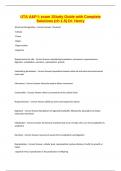UTA A&P I: exam 1Study Guide with Complete
Solutions (ch 1-5) Dr. Henry
Structural Orangization - Correct Answer -Chemical
-Cellular
-Tissue
-Organ
-Organ system
-Organism
Requirements for Life - Correct Answer maintaining boundaries, movement, responsiveness,
digestion, metabolism, excretion, reproduction, growth
maintaining boundaries - Correct Answer Separation between internal and external environments
must exist
Movement - Correct Answer Muscular system allows movement
Contractility - Correct Answer refers to movement at the cellular level
Responsiveness - Correct Answer ability to sense and respond to stimuli
Digestion - Correct Answer Breakdown of ingested foodstuffs, followed by absorption of simple
molecules into blood
Metabolism - Correct Answer all chemical reactions that occur in body cells, sum of all catabolism &
anabolism
Excretion - Correct Answer removal of wastes from metabolism and digestion
Reproduction - Correct Answer -cellular level, reproduction involves division of cells for growth or
repair
-organism level, reproduction is the production of offspring
,Growth - Correct Answer increase in size of a body part of an organism
Humans are ______ individuals, cells must be kept alive - Correct Answer multicellular
Intergumentary system - Correct Answer Components: Skin, hair, nails, sweat and oil glands
Functions: Protection, regulate body temperature, eliminates some waste, detect sensation
skeletal system - Correct Answer Components: Bones and joints of the body and their associated
cartilages
Functions: Supports and protects, provides a surface area for muscle, aids body movement
Muscular System - Correct Answer Components: Muscles composed of skeletal muscle tissue
Functions: Produces body movements, such as walking, stabilizes body position, generates heat
nervous system - Correct Answer Components: Brain, spinal cord, nerves, and special sense organs,
such as the eyes and ears
endocrine system - Correct Answer Components: glands, pancreas, ovaries, and hormone producing
cells in several other organs
cardiovascular system - Correct Answer Components: Blood, Heart, and blood vessels
Functions:Heart pumps blood through body vessels, blood carries oxygen and nutrients to cells and
carbon dioxide and wastes away from cells and helps regulate acid-base balance. temperature, ad
water content of body fluids, blood components help defend against disease and repair damaged
blood vessels.
digestive system - Correct Answer Components: Organs of gastrointestinal tract, pharynx throat,
esophagus, stomach, large and small intestines and anus, also includes accessory organs like liver and
gall bladder
urinary system - Correct Answer Components: Kidneys, ureters, urinary bladder, and urethra
Function: Produces, stores, and eliminates urine, eliminates wastes and regulate volume and
chemical composition of blood
, lymphatic system - Correct Answer Components: Lymphatic fluid and vessels, including spleen,
thymus, lymph nodes, and tonsils
Functions: returns proteins and fluid to blood
respiratory system - Correct Answer Components: Lungs and air passage ways such as the pharynx,
trachea, bronchial tubes leading into out of the lungs
Functions: transfers oxygen from inhaled air to blood and carbon dioxide from blood to exhaled air
Reproductive system - Correct Answer Components: Gonads (testes and ovaries) and associated
organs
Survival Needs - Correct Answer nutrients, oxygen, water, normal body temperature, appropriate
atmospheric pressure
Catabolism - Correct Answer the breakdown of complex chemical substances into simpler
components
Anabolism - Correct Answer the building up of complex chemical substances from smaller, simpler
components
Polymer - Correct Answer A long molecule consisting of many similar or identical monomers linked
together by anabolism
Monomer - Correct Answer A simple compound whose molecules can join together to form polymers
Homeostatic control of variables involves three components - Correct Answer Receptor, control
center, and effector
homeostasis - Correct Answer is the maintenance of relatively stable internal conditions despite
continuous changes in environment
a condition of equilibrium in the body's internal environment




